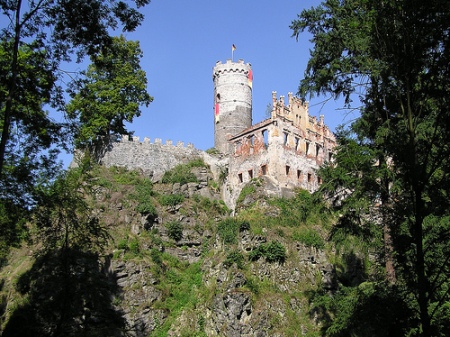

Location: North Bohemia Map
Constructed: 13th century by Přemysl Otakar II
Hauenštejn (also Horní hrad or Hauenstein) is a castle from the second half of the 13th century converted into a castle in the settlement of Horní Hrad near Stráž nad Ohří in the Ore Mountains in the district of Karlovy Vary. It has been protected as a cultural monument since 1964.
The castle was probably founded in the second half of the 13th
century as part of the border fortifications. However, this is not
certain. As a second possibility, the foundation of the castle by
its first documented owner – Mikuláš Winkler, burgrave of Loket, is
mentioned. However, he left it relatively soon to the monastery in
Doksany. On January 23, 1336, the monastery exchanged it with the
manor with the Czech king Jan Luxemburg for the Pulužní dvůr in
Velichov. Since then it remained as part of the royal property until
the time of Charles IV. He transferred it to an unknown owner. The
castle then changed its owner several more times and was used as a
pawn. Only in the 16th century did it fall into the hands of the
powerful Šlik family. After the fire (around 1600), they had it
rebuilt at great expense from the original Gothic to a new
Renaissance form. According to surviving reports from that time, a
brewery was also built at the castle. At this time, the castle park,
farm and wooden water supply system were also expanded. The Šlik
family held Hauenstein until 1663, when they sold it to Duke Julius
Henry of Saxony-Lauenburg. Since then, Hauenstein has been part of
the island estate. Julius Jindřich had the castle expanded and
carried out many structural modifications.
In 1689,
Hauenstein was inherited by Sibyl Augustus of France. The castle
thus fell into the hands of the August family. However, they died by
the sword in 1771, and the entire estate, including the castle,
became the property of the House of Habsburg-Lorraine. Since 1826,
it has been part of the so-called state estates. On October 30,
1837, it was sold to Countess Gabriele Buquoy as part of the sale of
state estates. The Buquoys then held Hauenstein until 1945. During
World War II, it was used as a Hitler Youth center. After the war,
it was confiscated and fell into the administration of the
Czechoslovak state. In 1947, after reconstruction, it was used as a
recreation center of the Jáchymov mines. Later, until 1958, a
detention children's home was located here again. Since then it has
not been used and has fallen into disrepair. The District National
Committee wanted to have it renovated several times, but did not
find sufficient funding or support for it. After 1982, it was even
considered to demolish it and preserve only the tower for tourist
purposes. However, the Institute of Monument Care did not abandon
its protection as a monument. After 1992, the Hauenštejn castle and
chateau came under the administration of the Krásný Les
municipality. The council looked for a buyer several times. It
wasn't until 1999-2000 that the current owner – Pavel Palacký –
bought the castle and chateau. Since then, he has been working with
an ever-growing group of people on the restoration of the castle and
its use as a cultural-tourist object.
There are two paths leading to the castle: the shorter one leads
visitors to the reconstructed Castle Gate, the other leads to the castle
courtyard and offers a view of the castle tower.
Above the castle on
the hill (465 m) is the Hornohradská chapel, from the interior of which
only one wooden bench has been preserved. New benches were purchased for
the chapel, exhibitions are held here. The interior displays a wooden
statue of St. Wenceslas, which was made for the pilgrim Peter "Hroch"
Binder's pilgrimage to the Vatican in 2007, where it was blessed by the
Pope.
At the chapel was Ing. Jaroslav Hejtík (1943–2001) founded a
botanical garden and arboretum in 1971, which is now managed and managed
by his son Jakub. The garden is planted with deciduous and coniferous
trees, some of which come from Japan, China, Korea and North America, as
well as traditional and lesser-known perennials, including rock plants
and medicinal plants.
During the season, a number of events take
place at the castle, such as the Jarní Slunohrad, Wicked Castle and
Folková Ohře music festivals, night tours, summer camps and outdoor
schools.
Since 2014, a group of volunteers from the "Opří se"
association has been returning here roughly four times a year with
children from orphanages. Since 2018, the association has organized
regular international workcamps here in cooperation with the INEX-SDA
organization.